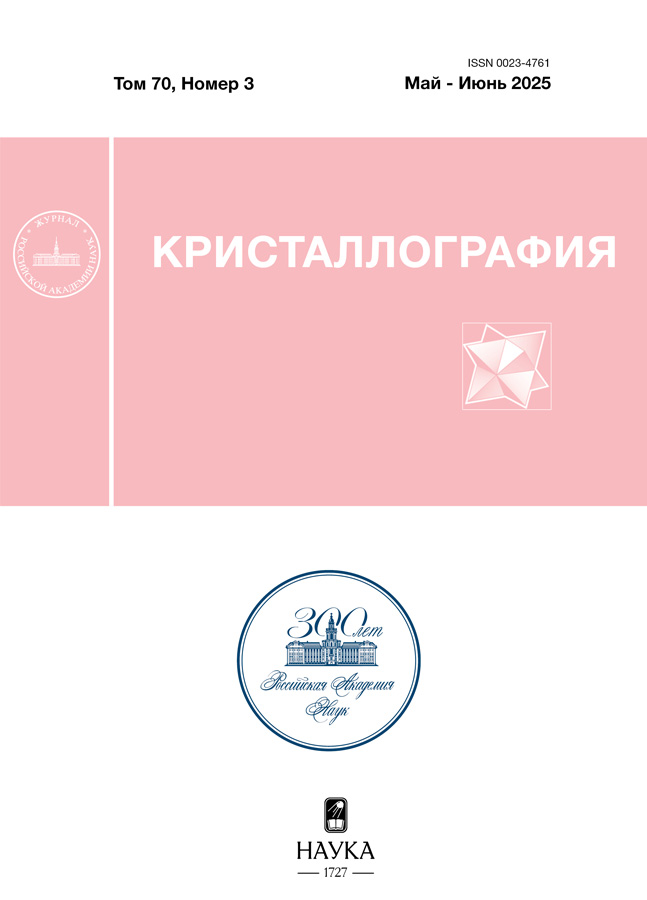Transformation series parakeldyshite-keldyshite: mechanism of transformation, chemical formula revision and crystal structure of keldyshite
- 作者: Panikorovskii T.L.1, Samburov G.O.1, Nikolaev A.P.2, Bazai A.V.1, Goychuk O.F.1, Pekov I.V.3, Krivovichev S.V.1,4
-
隶属关系:
- Kola Scienсe Centre of the Russian Academy of Sciences
- Apatite Museum and Exhibition Centre
- Moscow State University
- St. Petersburg State University
- 期: 卷 70, 编号 3 (2025)
- 页面: 434-447
- 栏目: СТРУКТУРА НЕОРГАНИЧЕСКИХ СОЕДИНЕНИЙ
- URL: https://bulletin.ssaa.ru/0023-4761/article/view/684967
- DOI: https://doi.org/10.31857/S0023476125030106
- EDN: https://elibrary.ru/BDDMJI
- ID: 684967
如何引用文章
详细
A holotype sample of keldyshite has been studied and found to consist of aggregates of partially protonated, Na-deficient parakeldyshite (which is predominant) and keldyshite itself. A series of laboratory experiments on the hydrolysis of parakeldyshite was conducted, leading to the clarification of the crystal structure of keldyshite formed during this process. An idealized refined formula for keldyshite, (Na□)ZrSi2O6(OH), has been obtained. As a result of the protonation of the oxygen atom at position O5 and the formation of strong hydrogen bonds (with an O5...O5 distance of 2.458 Å in keldyshite), a series of hinge transformations occurs, causing significant distortion of the Zr–Si–O framework within the crystal structure. The existence of the transformation series from parakeldyshite to keldyshite in nature has been confirmed. The mechanism for keldyshite formation can be described by the reaction scheme: Na+ + O2‒ → □ + (OH)‒. It is likely that the substitution reaction of parakeldyshite by keldyshite occurs via a transition from single crystal to single crystal.
全文:
作者简介
T. Panikorovskii
Kola Scienсe Centre of the Russian Academy of Sciences
编辑信件的主要联系方式.
Email: t.panikorovskii@ksc.ru
俄罗斯联邦, Apatity
G. Samburov
Kola Scienсe Centre of the Russian Academy of Sciences
Email: t.panikorovskii@ksc.ru
俄罗斯联邦, Apatity
A. Nikolaev
Apatite Museum and Exhibition Centre
Email: t.panikorovskii@ksc.ru
俄罗斯联邦, Kirovsk
A. Bazai
Kola Scienсe Centre of the Russian Academy of Sciences
Email: t.panikorovskii@ksc.ru
俄罗斯联邦, Apatity
O. Goychuk
Kola Scienсe Centre of the Russian Academy of Sciences
Email: t.panikorovskii@ksc.ru
俄罗斯联邦, Apatity
I. Pekov
Moscow State University
Email: t.panikorovskii@ksc.ru
俄罗斯联邦, Moscow
S. Krivovichev
Kola Scienсe Centre of the Russian Academy of Sciences; St. Petersburg State University
Email: t.panikorovskii@ksc.ru
俄罗斯联邦, Apatity; St. Petersburg
参考
- Герасимовский В.И. // Докл. АН СССР. 1962. Т. 142. № 4. С. 916.
- Хомяков А.П., Казакова М.Е., Воронков А.А. // Докл. АН СССР. 1969. Т. 189. № 1. С. 166.
- Хомяков А.П., Воронков А.А., Казакова М.Е. и др. // Тр. Минерал. музея АН СССР. 1975. Т. 24. С. 120.
- Хомяков А.П. Геохимия. Минералогия: Междунар. геол. конгр. XXV сес.: Докл. сов. геологов. Москва, 1976. С. 233.
- Хомяков А.П. // Докл. АН СССР. 1977. Т. 237. № 3. С. 703.
- Хомяков А.П. // Природа. 2011. № 12. С. 35.
- Воронков А.А., Шумяцкая Н.Г., Пятенко Ю.А. // Журн. структур. химии. 1970. Т. 11. № 5. С. 932.
- Сизова Р.Г. Воронков А.А., Хомяков А.П. // Структура и свойства кристаллов. Владимир: ВГПИ, 1974. № 2. С. 30.
- Халилов А.Д., Хомяков А.П., Махмудов С.А. // Докл. АН СССР. 1978. Т. 238. № 3. С. 573.
- Хомяков А.П. Минералогия ультраагпаитовых щелочных пород. М.: Наука, 1990. 200 с.
- Хомяков А.П. // Научные основы и практическое использование типоморфизма минералов. М.: Наука, 1980. С. 152.
- Хомяков А.П., Юшкин Н.П. // Докл. АН СССР. 1981. Т. 256. № 5. С. 1229.
- Хомяков А.П. // Развитие минералогии и геохимии и их связь с учением о полезных ископаемых. М.: Наука, 1983. С. 66.
- Юшкин Н.П., Хомяков А.П., Евзикова Н.З. Принцип наследования в минералогенезисе. Сыктывкар: Коми научный центр, 1984. 32 с.
- Khomyakov A.P. 30th Int. Geol. Congress. Beijing, 1996. V. 2/3. P. 450.
- Челищев Н.Ф., Хомяков А.П., Беренштейн Б.Г. и др. // А.с. 1096794 (СССР). Способ очистки газов от двуокиси серы / ИМГРЭ–ВАМИ. Б.И. 1984. № 21.
- Илюшин Г.Д., Демьянец Л.Н. // Кристаллография. 1988. Т. 33. С. 650.
- Зубкова Н.В., Пеков И.В., Турчкова А.Г. и др. // Кристаллография. 2007. Т. 52. № 1. С. 68.
- Zubkova N.V., Ksenofontov D.A., Chukanov N.V. et al. // Minerals. 2020. V. 10. № 3. P. 243. https://doi.org/10.3390/min10030243
- Zubkova N.V., Nikolova R.P., Chukanov N.V. et al. // Minerals. 2019. V. 9. № 7. P. 420. https://doi.org/10.3390/min9070420
- Чуканов Н.В., Пеков И.В., Расцветаева Р.К. // Успехи химии. 2004. Т. 73. Вып. 3. С. 227. https://doi.org/10.1070/RC2004v073n03ABEH000825
- Chukanov N.V., Pekov I.V. // Rev. Mineral. Geochem. 2005. V 57. P. 105. https://doi.org/10.2138/rmg.2005.57.4
- Pekov I.V., Chukanov N.V. // Rev. Mineral. Geochem. 2005. V. 57. P. 145. https://doi.org/10.2138/rmg.2005.57.5
- Пеков И.В., Зубкова Н.В., Пущаровский Д.Ю. и др. // Кристаллография. 2007. Т. 52. № 6. С. 1100.
- Nikolova R.P., Fujiwara K., Nakayama N., Kostov-Kytin V. // Solid State Sci. 2009. V. 11. № 2. P. 382. https://doi.org/10.1016/j.solidstatesciences.2008.07.003
- Kabanova N.A., Panikorovskii T.L., Shiloskikh V.V. et al. // Crystals. 2020. V. 10. № 11. P. 1016. https://doi.org/10.3390/cryst10111016
- Agilent Technologies CrysAlis CCD and CrysAlis RED. Oxford Diffr. Ltd, Yarnton, Oxfordsh. 2014.
- Sheldrick G.M. // Acta Cryst. C. 2015. V. 71. P. 3. https://doi.org/10.1107/S2053229614024218
- Brese N.E., O'Keeffe M. // Acta Cryst. B. 1991. V. 47. P. 192. https://doi.org/10.1107/S0108768190011041
- Dolivo-Dobrovolsky D.D. MINAL. http://www.dimadd.ru. Accessed 15 May 2016.
- McCusker L.B., Liebau F., Engelhardt G. // Micropor. Mesopor. Mater. 2003. V. 58. P. 3.
- Jeffrey G.A. An Introduction to Hydrogen Bonding, Oxford: Oxford University Press, 1997.
补充文件
















